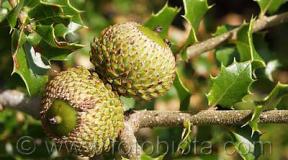Tannin farm group. Tannins. Cross-drug interactions
Active substance (international non-proprietary name)
Russian name: Tannin
Latin name: Tannin
Chemical name.
Gallobinic acid (tannin)
Characteristic.
Derived from ink nuts (Gallae turcicae), growths on young shoots of Asia Minor oak or domestic plants - sumach (Rhus coriaria L.) and scum (Cotinus coggygria Scop., Rhus cotinus L.), this sumach (Anacardiaceae).
Light yellow or brownish-yellow amorphous powder or flakes, or a porous mass of astringent taste, with a slight peculiar odor. Partially darkens in air and at artificial lighting, at 210-215 ° C decomposes into pyrogallol and carbon dioxide... Forms insoluble compounds with albumin, starch, gelatin, most alkali and metal salts. We will easily dissolve in water (1 g in 0.35 ml), we will dissolve in warm glycerin (1 g in 1 ml), we will dissolve well in alcohol and acetone. Practically insoluble in benzene, chloroform, ether, petroleum ether, carbon disulfide, carbon tetrachloride.
Pharmacology.
The astringent effect is due to the ability to induce the deposition of proteins with the formation of dense albuminates. When applied to mucous membranes or a wound surface, partial coagulation of proteins contained in mucus or wound exudate occurs, which leads to the formation of a dense protein film that protects the underlying tissues and the sensitive nerve endings located in them from irritation. Causes local vasoconstriction, reduces pain and helps to reduce the inflammatory response.
Indications.
Inflammatory processes in the mouth, nose, throat, larynx; burns, ulcers, cracks, bedsores; intoxication with alkaloids and heavy metal salts.
Contraindications
Hypersensitivity.
Side effects.
Allergic reactions.
Interaction.
Forms insoluble compounds with alkaloids and heavy metal salts.
Method of administration and dosage.
Outwardly, in the form of rinsing and smearing. At inflammatory processes in the mouth, nose, throat and larynx - in the form of rinsing (1-2% water or glycerin solution). For burns, ulcers, cracks and bedsores, 3-5-10% ointments and solutions are used. For gastric lavage in case of poisoning with salts of alkaloids and heavy metals, use 2 liters of a 0.5% aqueous solution.
Precautionary measures.
Inside tannin (as an antidiarrheal agent) is not taken, because it primarily interacts with proteins of the gastric mucosa and reaches the intestines in small quantities; when taken orally in large doses, causes loss of appetite and indigestion. Should not be prescribed for rectal fissures (in the form of enemas), because possible blood clots.
In acute poisoning with alkaloids, it should be borne in mind that with some alkaloids (morphine, cocaine, atropine, nicotine, physostigmine) tannin forms unstable compounds, therefore, when washing them, they should be carefully and as soon as possible removed from the stomach.
"Tannin" is used in the treatment and / or prevention of the following diseases (nosological classification - ICD-10):
Gross formula: C14-H10-O9
CAS Code: 1401-55-4
Description
Characteristic: Obtained from ink nuts (Gallae turcicae), growths on young shoots of Asia Minor oak or domestic plants - sumach (Rhus coriaria L.) and scumpia (Cotinus coggygria Scop., Rhus cotinus L.), family. sumach (Anacardiaceae).
Light yellow or brownish-yellow amorphous powder or flakes, or a porous mass of astringent taste, with a slight peculiar odor. It partially darkens in air and under artificial lighting, at 210-215 ° C it decomposes into pyrogallol and carbon dioxide. Forms insoluble compounds with albumin, starch, gelatin, most alkali and metal salts. We will easily dissolve in water (1 g in 0.35 ml), we will dissolve in warm glycerin (1 g in 1 ml), we will dissolve well in alcohol and acetone. Practically insoluble in benzene, chloroform, ether, petroleum ether, carbon disulfide, carbon tetrachloride.
pharmachologic effect
Pharmacology: pharmachologic effect- astringent, anti-inflammatory local, complexing, detoxification. The astringent effect is due to the ability to induce the deposition of proteins with the formation of dense albuminates. When applied to mucous membranes or a wound surface, partial coagulation of proteins contained in mucus or wound exudate occurs, which leads to the formation of a dense protein film that protects the underlying tissues and the sensitive nerve endings located in them from irritation. It causes local vasoconstriction, reduces pain and helps to reduce the inflammatory response.
Indications for use
Application: Inflammatory processes in the mouth, nose, throat, larynx; burns, ulcers, cracks, bedsores; intoxication with alkaloids and heavy metal salts.
Contraindications
Contraindications: Hypersensitivity.
Side effects
Side effects: Allergic reactions.
Interaction: Forms insoluble compounds with alkaloids and heavy metal salts.
Dosage and method of administration
Method of administration and dosage: Outwardly, in the form of rinsing and smearing. For inflammatory processes in the mouth, nose, throat and larynx - in the form of rinsing (1-2% water or glycerin solution). For burns, ulcers, cracks and bedsores, 3-5-10% ointments and solutions are used. For gastric lavage in case of poisoning with salts of alkaloids and heavy metals, use 2 liters of a 0.5% aqueous solution.
Precautions: Inside tannin (as an antidiarrheal agent) is not taken, because it primarily interacts with proteins of the gastric mucosa and reaches the intestines in small quantities; when taken orally in large doses, causes loss of appetite and indigestion. Should not be prescribed for rectal fissures (in the form of enemas), because possible blood clots.
In acute poisoning with alkaloids, it should be borne in mind that with some alkaloids (morphine, cocaine, atropine, nicotine, physostigmine) tannin forms unstable compounds, therefore, when washing them, they should be carefully and as soon as possible removed from the stomach.
Tannins, or tannic acid, are water-soluble polyphenols (complex natural organic compounds) found in many plant foods.
From French, the name is translated as "tanning leather", which determines one of the main abilities of the substance.
general characteristics
Tannins are yellow-brown powder. This substance is often found in plants, mainly in the roots, bark of trees, leaves, and some fruits. High concentrations are found in the bark of oak.
Tannin solutions are astringent acids. V Food Industry gives the products a tart taste, a certain color and aroma. Tannic acid is used in winemaking and brewing. And thanks to its astringent properties, it has found application in medicine - for the treatment of tonsillitis, pharyngitis, skin rashes, hemorrhoids.
Water-soluble tannins with compounds form a dark blue or dark green solution. This property allows tannins to be used to make ink. In light industry it is used for the production of leather, dyeing fabrics.
Classification of tannins
Considering Chemical properties, there are 2 groups of tannins: hydrolysable (dissolve in water) and condensed.
Representatives of the first group, after hydrolysis with acids or enzymes, create gallic and ellagic acids. From a chemical point of view, they are phenolic acid esters. Gallic - mainly found in rhubarb, cloves, and ellagic - in eucalyptus leaves and pomegranate bark.
Condensed tannins are resistant to hydrolysis and are produced from flavonoids. These substances are found in henna bark, male fern seeds, tea leaves, and wild cherry bark.
Physicochemical properties
Tannin creams relieve swelling and itching, and tannin powder is used as a bath additive.
Medical tannin properties:
- relieves itching;
- heals all sorts of inflammation;
- gets rid of germs that cause disease;
- prevents dehydration of the epidermis;
- fights viruses with eczema, herpes, chickenpox;
- heals postoperative wounds;
- used in urology, gynecology, proctology;
- effective for healing first-degree burns;
- an effective medicine for dermatoses in children.
Meanwhile, it should be noted that not only a synthetic analogue of a substance is used as a medicine. ethnoscience often resorts to the use of plants rich in tannic acid. For example, galangal (root) treats diarrhea, chestnut strengthens the walls of blood vessels, eucalyptus is an effective remedy for colds. In addition, acorns (used as a substitute for coffee) and sumac (used as a spice in oriental cuisine) have a beneficial effect on the body. Most tannin-rich plants have similar positive effects on the body.
The "dark" side of tanning agents
 Too active consumption of products containing tanning agents is fraught with not the most pleasant consequences. In particular, digestive disorders, liver or kidney dysfunction are possible. Under the influence of tannins, irritation of the intestinal walls is possible. An excess of tannic acid interferes with the proper absorption of useful minerals, in particular iron, which is fraught with the development of anemia.
Too active consumption of products containing tanning agents is fraught with not the most pleasant consequences. In particular, digestive disorders, liver or kidney dysfunction are possible. Under the influence of tannins, irritation of the intestinal walls is possible. An excess of tannic acid interferes with the proper absorption of useful minerals, in particular iron, which is fraught with the development of anemia.
It is important to treat these substances with extreme caution for people whose body does not accept tannins. Otherwise, allergies with very serious consequences are possible. It is also important to avoid tannin-containing foods for people with heart failure and unstable blood pressure... Excessive consumption of tannins can cause indigestion and impair appetite.
Tanning rich foods
Probably if someone wanted to compose full list products containing tannins, it would be necessary to rewrite almost all representatives of the terrestrial flora, since almost all plants in one concentration or another in their various parts contain tannins. We will name only the most popular products in which the concentration of tannins is close to the maximum.
Drinks: tea, cocoa.
Berries: grapes (dark varieties), black currant, dogwood, bird cherry, pomegranate.
Fruits: quince, persimmon.
Vegetables: rhubarb, red beans.
Nuts: walnuts, almonds.
Spices: cinnamon, cloves.
In addition, acorns, chestnuts, eucalyptus, galangal root and dark chocolate contain powerful stores of tannins.
As a dietary supplement
In the food industry, tannins are known as an additive E181 (stabilizer, emulsifier, dye) - a yellow-brown powder with an astringent taste and a specific odor. Extracts of plants of the genus Sumac and Gauls are used as raw materials for E181.
The substance has earned its popularity in the food industry due to its ability to impart an astringent flavor. In addition, it is actively used due to the ability to protect the peel of vegetables and fruits from rotting and drying out. If we talk about the effect on taste buds, then this substance is a bit like glutamic acid, and gives food a specific taste of savory. Also tannic acid in the form E181 is used as a clarifier for beer, wine and other products.
 If you are a wine lover, then you've probably heard of the so-called tannin drinks. Although it is possible, for many it remains a mystery what it is - the concentration of tannin in wine, and what is the role of tannins in winemaking. Now let's try to clarify what is in wine and why some of these drinks cause severe headaches.
If you are a wine lover, then you've probably heard of the so-called tannin drinks. Although it is possible, for many it remains a mystery what it is - the concentration of tannin in wine, and what is the role of tannins in winemaking. Now let's try to clarify what is in wine and why some of these drinks cause severe headaches.
The effect of tannins is easy to recognize even after the first sip of wine - this is the characteristic dry mouth and tart aftertaste. Depending on the intensity of these effects, we can talk about the level of concentration of tannins in the drink.
Tannic acid comes into the composition of wine in two ways: from certain grape varieties and from wood. Grape tannin is found mainly in the skin, seeds and stems of the berry. In red wines, its amount is much higher. In addition, the concentration of tanning agents depends on the grape variety.
Another way of tannins in a glass of wine is through wood. Or rather, the barrel in which the drink was stored. Oak vessels are the most popular in winemaking, as they give the drink a specific flavor. Ordinary tea will help you more correctly understand what the taste of tannin is. It is enough to brew a strong drink (no sweeteners) and infuse it a little longer than usual. The very first sip of this tea will immediately make you understand everything about the taste of tannin. A light bitterness on the middle of the tongue and a tart dryness on the tip - this is tannin in action. Essentially, black tea is an aqueous solution of tannin.
The concentration of tannic acid in wine depends not only on the grape varieties from which the drink is made, but also on how long the skin, seeds and stems have been in contact with the juice of the berry. In the production of red wines, in order to obtain a deeper color, the berry peel is aged in the juice for a longer time. This explains why significantly more tanning agents are found in this wine variety. But this does not mean that white varieties are devoid of tannins. Tannic acid gets into them, first of all, from oak barrels, and similarly imparts dryness, astringency and bitterness to white wines.
But tannins in winemaking are used not only to improve taste. In this area, tanning agents, among other things, play the role of natural ones, which contribute to the long-term storage of grape drinks. Meanwhile, over the years, the concentration of tannic acid in wines is lost, which affects the taste of the drink, and it becomes softer.
But wine tannins also have their drawbacks. Some people react to tannic acid with severe headaches. This explains the migraines that some wine lovers suffer, even after a very small portion of the drink. Therefore, people who are sensitive to tannin, it is better to enjoy white varieties, so as not to suffer the next day.
Tannin in tea
But wine isn't the only drink that contains tannins. In tea, the concentration of this substance is also quite high. Tannic acid is present in all types of drink, but, as with grapes, some varieties contain more of it.
First of all, this applies to green varieties. Some of them have a tannin content of over 30 percent. But it's worth noting that the concentration of tannic acid in tea plants depends on several factors. Firstly, it is important in what climatic and natural conditions the product was grown. It is believed that the concentration of tannins in Ceylon, Indian and Javanese teas is higher, hence their amazing tart flavor. In addition, in the leaves collected in July or August, the substance is much higher than in drinks "born" in May or September. Secondly, the age of the plant also matters: the maximum amount of tannins is found not in young shoots, but in older leaves.
By the way, the tannic acid contained in tea chemical composition somewhat different from its counterpart from other products and synthetic "brother". Tea tannins resemble vitamin P and have a strengthening effect on blood vessels.
Tanning agents and industry
If you remember that the French name for tannins is translated as "tanning leather", it becomes clear in which industry this substance is most often used. Sheepskin coats and furs, which we all love to wrap ourselves in in cold winters, are the result of the use of tannins. In addition, the production different types mankind also owes ink to tannins. And the stain of textile fibers without tannins is also difficult to imagine.
Interaction with other substances
Scientists continue to study the properties of tannin, since there is still a lot of unknown in the biography of this substance. In particular, scientists analyze how tannic acid affects the body, and especially how it "gets along" with other useful elements.
Currently, for example, the combination of tannin and caffeine (which is represented in tea) is perhaps the most studied. In this unusual "cocktail" of substances, scientists were primarily interested in why tea, which contains a fairly high concentration of caffeine, has a relaxing effect on the body. It turned out that all this is the merit of tannin, which, in combination with caffeine, does not invigorate the body (like coffee), but, on the contrary, as a relaxation agent and causes restful sleep... But besides the impact on nervous system, tannins act as protectors for liver cells. In particular, the body needs the protective effect of tannic acid after alcohol abuse.
If we talk about the combination of tannin with other medicines, then it interacts well with antimicrobial drugs and antibiotics.
Tannin does not belong to substances, oh useful properties which is known to almost everyone. Moreover, many people do not even know about the existence of tannic acid and its role for humans. Meanwhile, tannins do not just exist, but make our life much easier. And if you have read this text to the end, then now you know almost everything about the role of tanning agents.
Sources of
- V.L. Kretovich Plant Biochemistry: A Textbook for Biol. faculties of un-tov. - M .: Higher. shk. - 1980 - S. 307 - 308.
- Kurkin V.A. Pharmacognosy: Textbook for students. pharmaceutical universities / V.A. Kurkin. - Samara: LLC "Etching", GOUVPO "SamGMU". - 2004 .-- S. 867 - 876.
Name:
Tannin (Taninum)
Pharmachologic effect:
Astringent, anti-inflammatory.
Indications for use:
With stomatitis (inflammation of the mucous membrane of the oral cavity), gingivitis (inflammation of the mucous membrane of the gums), pharyngitis (inflammation of the pharynx), inflammatory diseases of the oral cavity, pharynx, with burns, ulcers, cracks, bedsores (tissue necrosis due to prolonged pressure on them while lying down) , for gastric lavage in case of poisoning.
Application method:
1-2 % water solution for rinsing 3-5 times a day, topically for burns, ulcers, cracks, bedsores (3-5-10% solutions and ointments), for poisoning with alkaloids, heavy metal salts 0.5% aqueous solution for gastric lavage.
Release form of the drug:
Storage conditions:
In a tightly sealed container.
Synonyms:
Gallodubic acid.
Drugs with a similar action:
Happylor Panthestin Medasept AHD 2000 AHD 2000 Etonium
Dear doctors!
If you have experience in prescribing this drug to your patients - share the result (leave a comment)! Did this medication help the patient, did any side effects occur during treatment? Your experience will be of interest to both your colleagues and patients.
Dear patients!If you have been prescribed this medication and you have undergone a course of therapy, tell us if it was effective (helped), if there were side effects, what did you like / dislike. Thousands of people search the Internet for reviews of various medications. But only a few leave them. If you do not personally leave a review on this topic, the rest will have nothing to read.
Many thanks!The site provides background information for informational purposes only. Diagnosis and treatment of diseases must be carried out under the supervision of a specialist. All drugs have contraindications. A specialist consultation is required!
basic information
Tannins(galactic acids, tannic acids) are phenolic compounds containing a large number of –OH groups. Widely distributed in the plant kingdom. They are characterized by tanning properties and a specific astringent taste. Able to form strong bonds with proteins, complex carbohydrates and other natural polymers.Being in nature
Tannins are found in the bark, wood, leaves, fruits (sometimes seeds, roots, and tubers) of many plants. A large number of them are found in the following plants:- chestnut;
- larch;
- tsinkhona;
- sumach;
- quebracho.
Tannic acid protects plants from wide range pathogenic microbes, and also protects them from being eaten by insects and animals.
Receiving
Tannins are obtained mainly from ink nuts of oak, acacia, spruce, chestnut, etc. In the final form, the resulting product is a light yellow powder with a mild specific odor and astringent taste. The powder is soluble in water, alcohol and glycerin.Chemical properties
An aqueous solution of tannins has an acidic reaction and has pronounced tanning properties. When interacting with alkaloids, solutions of proteins and salts of heavy metals, they form precipitates.Synthetic tannin
 Until the middle of the 20th century, exclusively natural tannic acids were used, which were obtained mainly from the ink nuts of oak bark. However, in 1950, thanks to the development of chemistry, a cheap way of producing artificial tannin was found. Synthetic tannin, showing all the properties of natural tannic acids, at the same time surpasses them in a number of criteria:
Until the middle of the 20th century, exclusively natural tannic acids were used, which were obtained mainly from the ink nuts of oak bark. However, in 1950, thanks to the development of chemistry, a cheap way of producing artificial tannin was found. Synthetic tannin, showing all the properties of natural tannic acids, at the same time surpasses them in a number of criteria: - synthetic tannin can be obtained in its pure form, while natural tannin cannot be eliminated from impurities;
- thanks to the convenient consistency, it became possible to more accurately measure the dosage;
- Plants from which natural tannic acids are obtained are not controlled, while the production of artificial tannin is controlled at all stages.
Only one artificial tannin is known today. A number of drugs are produced on its basis. One of the most famous, developed by the German pharmaceutical giant Derma-Pharm, is Delaskin. It is produced in the form of a cream and powder, as well as in the form of bath additives.
Industrial applications
Tannins are widely used in industry:- production of tanned leather and fur;
- manufacturing of ink;
- mordant textile fibers;
- creating a tart and astringent taste in certain drinks;
- as a food coloring.
Food coloring E181 (tannin) is a light yellow powder, soluble in alcohol, water and glycerin.
Application in medicine
Tannic acids are widely used in medicine. As a rule, synthetic tannin is used in clinical practice. The spectrum of its application in clinical practice is presented below:- inflammation oral cavity, larynx or gums, with a runny nose, colds, laryngitis, etc.;
- burns, ulcers, cracked nipples, soft tissue necrosis;
- intoxication with alkaloids (except for morphine, cocaine, atropine, nicotine, eserine salicylate, which form bonds with tannin, which are destroyed under the influence of gastric juice);
- as astringents;
- as an antidote (for intoxication with salts of lead, mercury and other heavy metals);
- as a remedy for diarrhea;
- in order to improve blood clotting;
- for the treatment of hemorrhoids;
- various dermatological viral infections (eczema, exanthema, herpetic infections, etc.);
- viral pathologies (chickenpox, papular acrodermatitis, etc.);
- treatment of surgical wounds in urology, proctology and gynecology;
- healing of first-degree burns and cracks in the anus;
- baby skin diseases(erythema of the buttocks, impetigo, intertrigo, sweating of the feet, etc.).
Creams based on synthetic tannin are designed to relieve puffiness, irritation and itching, help reduce pain syndrome and local inflammation. On healthy skin acts as an antiperspirant, reducing the secretion of sweat and sebum.
Also available are tannin-based powders for the preparation of baths and cold compresses.
Contraindications
 Modern doctors do not recommend tannin for ingestion (for the treatment of diarrhea), since it, first of all, binds to proteins of the gastric mucosa, and reaches the intestines in insufficient volume. Ingestion in high volumes leads to dyspepsia and impaired appetite. It is not recommended for use in anal fissures (in the form of enemas), since there is a risk of blood clots. At acute intoxication with alkaloids, it is necessary to take into account that tannin creates unstable compounds with certain alkaloids (morphine, cocaine, atropine, nicotine, physostigmine), therefore, gastric lavage should be carried out as soon as possible.
Modern doctors do not recommend tannin for ingestion (for the treatment of diarrhea), since it, first of all, binds to proteins of the gastric mucosa, and reaches the intestines in insufficient volume. Ingestion in high volumes leads to dyspepsia and impaired appetite. It is not recommended for use in anal fissures (in the form of enemas), since there is a risk of blood clots. At acute intoxication with alkaloids, it is necessary to take into account that tannin creates unstable compounds with certain alkaloids (morphine, cocaine, atropine, nicotine, physostigmine), therefore, gastric lavage should be carried out as soon as possible. Side effects
In persons sensitive to tannic acids, excessive use of the E181 dye can provoke a number of adverse reactions... The following are the main symptoms of E181 intoxication:- intestinal irritation;
- impaired renal function;
- liver intoxication;
- irritation of the digestive tract.
Security
In addition to its therapeutic properties, serious safety conditions are imposed on each drug. Since tannin has a high molecular weight and an astringent effect, it is not able to penetrate into the deep layers of the skin. Therefore, it is well tolerated and has few side effects. Tannin quickly penetrates and remains in the upper layer of the skin, providing healing effect and without disturbing the systemic circulation.In many situations, the use of tannin is preferable to the use of topical glucocorticoids, since the latter have a number of contraindications and side effects with prolonged use. This is especially important in pediatric practice.
In order to avoid undesirable consequences, it is recommended to obtain medical advice before using the tannin preparation.
Interaction with other medicines
Medicines based on artificial tannins work well with antibiotics and etiotropic medications.Skin diseases
Every person during his life suffers from one or another skin disease. The most common of them are chickenpox, eczema, dermatitis, herpes, shingles, intertrigo, etc. Most of these conditions share a common set of symptoms: inflammation, itching, redness, and rashes. In dermatology, a medical science that studies diseases of the skin and mucous membranes, tannins (tannins) have been used for many years. When interacting with proteins, they create a thin film on the surface of the skin, as a result of which the vessels of the skin are narrowed, the separation of exudate decreases, and the barrier function of the skin is enhanced. All of the above processes lead to a stop of the inflammatory reaction.Initially, tannins were used in medicine solely for their astringent properties. When treating the wound surface, they bind structural proteins, and together with them create a specific film on the skin surface, due to which the wound stops oozing, the wound surface becomes dry, and recovery processes are accelerating.
Clinical trials and observations of persons receiving treatment in hospitals made it possible to identify three more medicinal properties synthetic tannin:
- Antipruritic effect. Most dermatological pathologies are characterized by a symptom such as itching. Itching is a local unpleasant tingling or burning sensation triggered by the innervation of nerve fibers. In the course of clinical studies, using electrical impulses, a high threshold of susceptibility was established at which a person begins to feel itching. This indicates the high antipruritic properties of tannin.
- Anti-inflammatory effect. Clinical trials carried out in hospitals around the world have shown that tannin also has an anti-inflammatory effect, which is extremely important in the treatment of diseases such as psoriasis, which affects up to 2% of people. During the experiment, irritation was artificially caused by skin contact with sodium laurisulfate, which provokes allergic reaction, and has toxic properties. After applying tannin to the same area of the skin, a rapid reduction in redness was observed, demonstrating its anti-inflammatory properties.
- Antibacterial effect. Many pathologies are complicated as a result of the pathological influence of certain microorganisms. For example, clinical practice indicates that diffuse neurodermatitis (chronic allergic disease) is often accompanied by staphylococcal infection, which actively multiplies on the surface of the skin. Tannin, in turn, reduces the release of exudate, thereby preventing the multiplication of bacteria, which need a special environment for their vital activity (in this case, the constant release of exudate).
Another pathological manifestation of dermatitis is transepidermal water loss. Over time, this symptom leads to drying and loosening of the layers of the skin, which becomes vulnerable to bacteria and toxic substances. Clinical researches demonstrated that with regular skin treatment medicines with artificial tannin, the rate of fluid loss is significantly reduced.
Tea tannins
 Tannins (tannins) are one of the most important components of tea and tea infusion. 15-30% of tea consists of tannic acids. In the past, tea tannin was considered a simple tannin and was generally believed to have a bitter taste. But later, thanks to the research of academician A.L. Kursanov, this view has been changed. It was found that tea tannin (theotanin) differs from the synthetic analogue and from the tannic acids found in other plants. Theotanine is a complex complex chemical compounds, the structure of which is fully understood today. The previous opinion that tannin creates the bitter taste of the drink turned out to be mistaken. If in a fresh leaf of a tea bush the theotanine really creates a bitter aftertaste, then after the standard tea-making procedure this aftertaste disappears. Subsequently, the theotanine acquires a pleasant astringency, which creates the main taste of the drink.
Tannins (tannins) are one of the most important components of tea and tea infusion. 15-30% of tea consists of tannic acids. In the past, tea tannin was considered a simple tannin and was generally believed to have a bitter taste. But later, thanks to the research of academician A.L. Kursanov, this view has been changed. It was found that tea tannin (theotanin) differs from the synthetic analogue and from the tannic acids found in other plants. Theotanine is a complex complex chemical compounds, the structure of which is fully understood today. The previous opinion that tannin creates the bitter taste of the drink turned out to be mistaken. If in a fresh leaf of a tea bush the theotanine really creates a bitter aftertaste, then after the standard tea-making procedure this aftertaste disappears. Subsequently, the theotanine acquires a pleasant astringency, which creates the main taste of the drink. Usually, the concentration of tannic acids in green tea is significantly higher than in black (almost 100%), since the tannin of green tea is almost unoxidized, while in black about 50% of this substance is in an oxidized state. As for black teas, the concentration of tannic acids in South Asian varieties (Indian, Ceylon, Javanese) is higher than in Chinese, Georgian, Krasnodar, etc. Tannin gives South Asian teas a sharper, more distinct flavor, which is why they have gained such popularity. As for the Georgian varieties, the leaves of the July and August harvests contain much more tannin than the May and September ones. You should also know that in all the higher grades teas, the concentration of tannins is higher than in the lower grades.
Tannic acids in tea are not stable substances. The products of their reaction with oxygen - quinones, formed during the factory production of tea, in turn oxidize other components of raw tea, as a result of which a number of aromatic compounds are released, which are involved in creating the smell of tea. Thus, the role of tannic acids in tea can hardly be overestimated. In addition, they do not have a tanning effect on the gastric mucosa, as previously thought.
Another important property of tea theotanins and catechins is their similarity to vitamin P. Therefore, due to the high concentration of tannin, tea is one of the main sources of this vitamin for modern humans.
And finally - everyone knows that green tea strengthens blood vessels, but few people know that this healing property tea is due precisely to the tannins present in it.
Wine and winemaking
 The quality of red wines is directly determined by the quantity and origin of tannins. For centuries, winemakers have invented more and more new methods of extracting the highest quality tannic acids into wine. They are part of the skins of grape berries, in the stalks, and also in the seeds.
The quality of red wines is directly determined by the quantity and origin of tannins. For centuries, winemakers have invented more and more new methods of extracting the highest quality tannic acids into wine. They are part of the skins of grape berries, in the stalks, and also in the seeds. The highest quality tannins are found in the skins of berries. They are soft, and most of them are found in ripe grapes. The tannins extracted from the stalks lack pungency, and the tannins of the seeds are the hardest. Therefore, winemakers always try to reduce the amount of extraction from the stalks, and especially from the seeds.
In red wines, the proportion of tannins is much higher than in white wines, which is partly a factor in their difference. The amount of tannin in wine changes over time. As a rule, the most tannins are found in young red wines. This is considered their main disadvantage, especially if the wine tastes too tart.
However, tannin is an essential component of wine for long-term storage. It not only regulates the taste and color of the wine, but also acts as a preservative, protecting the product from the damaging effects of oxidative enzymes. The wine's long-lasting color retention is also due to its antioxidant properties. After a certain time, it is tannin that creates the structure of the wine, softening its taste. Therefore, if the wine is produced for long-term storage (more than two years), then the excess of this substance is considered one of its main advantages.


















